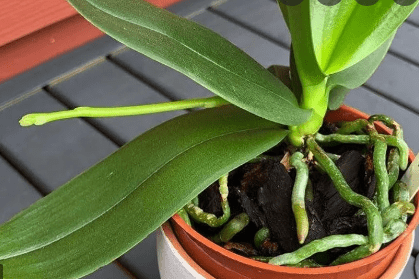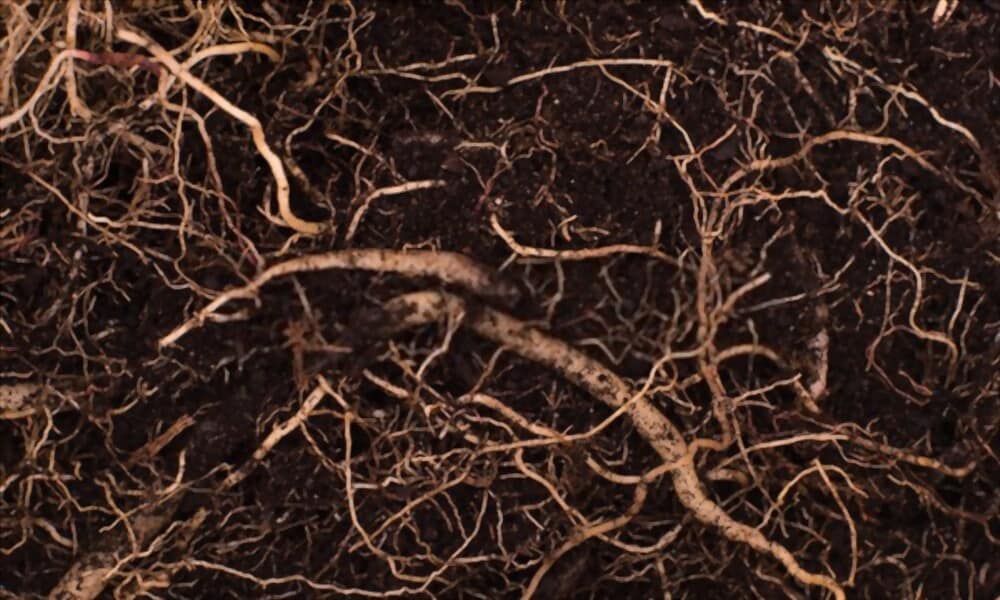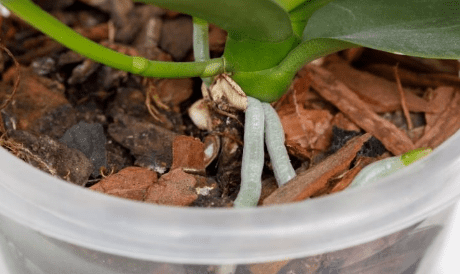
As heterotrophic organs (parts that do not make their own food), roots typically develop underground and rely on the shoot and leaves for nourishment and sustenance.
When exposed to light, roots will turn green, which can lead to an accumulation of algae on the root’s surface. Because they contain chlorophyll, algae commonly used in aquaponics, hydroponics, and water-grown plants give their roots a green tint. Reduce the root’s exposure to light to prevent green roots.
The adventitious roots of some plants have undergone modification, making them an exception. Air plants, orchids, and monsteras frequently have these so-called aerial roots that develop above earth and contribute to the photosynthesis process, which helps the plant produce food.
In this article, we talk about what makes a plant’s roots become green and if this happens to all plants on occasion. Are there any plants with green roots?
Table of Contents
What Causes Plant Roots To Be Green?
In general, photosynthesis is related to plants’ green hue. Typically, leaves and shoots undertake the majority of the photosynthetic effort, which involves absorbing sunlight and converting water, carbon dioxide, and light into energy and oxygen.
Chloroplasts are tiny organelles found inside plant cells that can store solar energy in plant leaves. The lush green hue of plant leaves is a result of chlorophyll in the chloroplast.
However, some air plants (epiphytes) have green roots that actively participate in or carry out the entire process of photosynthesis.
The following is a list of factors that may cause the roots of your plants to become green:
Light:
Exposure to sunshine is the main cause of the greening of plant roots. Sunlight has a profound impact on the development and regular operation of roots.
The Development and Function of Roots, a book by botanists D. T. Clarkson and J. G. Torrey published in 1975, provided insight into the function of green roots. Both writers assert that some plants’ roots turn green when they are exposed to sunlight or when they form as adventitious organs, as in the case of leafless orchids. Orchids’ aerial roots have chloroplasts, which can undertake active photosynthesis by capturing solar energy.
Later in 1977, during their research, Gill and Tomlinson also noted green roots and the Red Mangrove roots’ capacity for photosynthetic activity.
According to botanists, hairy roots react to changes in the environment and light stimulation. When cultivated in the sunlight, the hairy roots of Asteraceae, Solanaceae, and Cucurbitaceae can turn green.
According to Dr. Hector E. Flore of The Pennsylvania State University, “Roots of all plant species in the Asteraceaegenera genera displayed greening and photosynthetic capabilities when exposed to the sunlight.”
So, avoid exposing your roots to direct sunlight if you don’t want them to turn green.See our in-depth posts on why plant roots show, how to correct it, and whether or not light is detrimental for plant roots for more information.
When I have soil-related issues, such as as I need to top off when roots start to appear, I use this Miracle-gro potting mix from Amazon. Clicking here will take you there.
Shrub and Tree Roots Above Ground:
When trees and bushes are grown above ground, you may occasionally observe that their roots turn green.
The roots activate their chloroplasts in response to sunlight stimulation, utilizing the energy of the sun for photosynthesis.
The majority of orchid species have green, hairy roots that take part in photosynthesis. It’s interesting to note that the chloroplast found in the green roots of leafless orchids (Praecoxanthus aphyllus) are entirely responsible for the plant’s photosynthesis, which results in the production of sugars.
How Does Light Affect Roots?

The growth, development, and activity of plant roots can be dramatically changed by sunlight. It’s a fallacy that roots grow in complete darkness, despite the fact that the majority of plant roots live underground. A couple of millimeters beneath the soil’s surface, sunlight can penetrate.
The direction, growth rate, and development of root architecture can all be strongly impacted by sunlight.
Plants have developed over time to become more sophisticated and incredibly sensitive to inputs from sunshine. There are numerous photoreceptors in plants (cells that respond to light).
Because some of these photoreceptors are also found in the roots, roots may detect light and respond appropriately.
Directly or indirectly, light may have an impact on:
- growing roots
- Root structure
- Root hair development
- beginning of lateral roots
- Gravitational and light-related root gravitropic bending
Propagation Methods That Can Result in Green Roots:
If you are propagating your plants in one of the following ways, light can readily impact them and cause them to turn green:
Aquaponics:
Green roots are possible in plants cultivated in an aquaponic system. There are primarily two causes for that.
- One, there’s a chance that sunlight is reaching your plants.
- Two, the root’s surface or the water both have algal growth.
Anywhere there is moisture, algae will develop, especially in aquaponic systems where there is a lot of water.
Hydroponics:
The greening of roots is a typical symptom of hydroponically cultivated plants.
When growers utilize transparent or glass containers that can transmit light, the roots of the plants typically turn green. As we previously said, roots exposed to direct or indirect light will turn green.
The synthesis of chloroplasts and chlorophyll is stimulated by light, which causes roots to turn green.
For instance, when grown hydroponically, the roots of the Peace lily turn green.
However, the ability of the plant species to manufacture chloroplast in the roots is what determines whether the roots turn green. Even if you set your roots in bright sunlight, they won’t turn green if there are no chloroplast present.
Planting in Glass Planters or Clear Plastic Containers:
Plants grown in glass or clear plastic containers allow light to easily pass through them, stimulating the synthesis of chloroplasts and chlorophyll.
Your roots will eventually begin responding to light by activating their photosynthetic capacity and turning green.
Propagating Plants in Glass Jars:
Glass jars operate in a similar manner. Glass jars make it simple for light to enter and go to your plant’s roots. Your plant will quickly turn green if it can increase the production of chloroplasts in the roots.
Why Aren’t Roots Green Like Leaves?
The absence of chloroplast and sunlight is the primary factor preventing roots from being green like leaves.
The chloroplast found in leaf cells is what gives leaves their green color. Chlorophyll is found in the layer or membrane of the chloroplast (the photosynthetic pigments).
The primary function of the pigment chlorophyll is to absorb various sunshine spectrums. The deep-blue and red light spectrums are easily absorbed by it. But the remainder of the spectrum is reflected, giving the leaves their green appearance.
Chloroplast is not always found in the roots of plants. Even if there are some, the ratio is incredibly low because there isn’t any sunshine.
Chloroplasts and the color green are only present in the plant’s aerial portions (stems, leaves, and petioles) that are exposed to sunlight.
The plant’s roots receive very little sunlight because they are largely submerged underground.
Because the roots are unable to absorb the various sunshine spectrums, there is no reflection and the leaves are not green.
When roots with chlorophyll are exposed to sunlight, especially aerial roots, they immediately turn green. Because of a lot of rain, wind, unexpected temperature fluctuations, earthquakes, etc., they could be exposed to direct sunlight.
Why Do Algae Grow on Roots and How To Remove It?
When your roots acquire some surface algae, they may seem green. Anywhere there is water, sunlight, and nutrients, algae may grow quickly.
Algae, the organism that resembles a plant, is an aquatic organism, hence it won’t exist if there isn’t any water. They also require a lot of sunlight to develop. Warm water and direct sunlight encourage algae growth more quickly.
Algae thrive best in propagation systems, particularly hydroponic and aquaponic systems with recirculating nutrient solutions and sunlight.
Both of these propagation methods primarily saturate the roots with water. Water-grown algae adheres to the surface of the root.
How To Fix Green Roots?

Remove the Algae:
Sanitation is the first important step in preventing algae. Make your hydroponic or aquaponic system more hygienic and maintain it. Before using the tools and equipment, disinfect them and change the water frequently.
Algaecide chemicals like hydrogen dioxide and peroxyacetic acid can also be used to destroy or remove algae development.
If the algae has already developed on your roots, you may simply wash the roots with clean water to get rid of them. Take these actions:
- Put on gloves because you don’t want to in any way infect your roots.
- Remove the roots of your plant carefully from the water.
- When deciding on the water’s temperature to wash the roots, exercise particular caution. Your plant could be stunned and die if the water is too hot or too cold.
- Wash the roots gently and thoroughly.
- Put the roots back in the freshwater once the green has faded and they appear white or colorless.
Cover the Roots-
Hydroponics and Aquaponics
By making sure that the roots in hydroponic or aquaponic systems are not exposed to light, green roots can be avoided.
They are typically cultivated in net cups with holes in water culture, which allows some light to enter the pipes or rails.
The light won’t penetrate the cavity containing the plant as long as the holes supporting the net cups are the proper size. Because mold cannot grow as a result, the roots are not exposed to light.
Potted Plants
In other situations, such as in potted plants and grounded plants, exposed roots may be exposed to excessive light, which will result in the growth of algae on the roots’ surface.
Repotting or topping off the dirt to cover the roots are two options for potted plants. The soil in potted plants occasionally has a tendency to sink, which can expose the roots to the air and light.
For more information on why soil in potted plants sinks, see our in-depth post.
Here, covering the roots with potting soil is an easy fix.
- Why Plant Leaves Aren’t Opening or Unfurling: Reasons Why
- Are Plants Affected by Moonlight? The Farming Process Described
- What You Need To Know and Do If You Just Scatter Seeds
- Is hydrogel beneficial for houseplants? Here is why and how much.
- How Much Do House Plants Cost to Maintain? What to Expect
FAQ
Yes, some epiphytic and climbing plants’ roots do produce chlorophyll and turn green to carry out the process of photosynthesis. A root like this is known as an assimilatory root or a photosynthetic root.
Why do roots turn green?
When growers utilize transparent or glass containers that can transmit light, the roots of the plants typically turn green. As we previously said, roots exposed to direct or indirect light will turn green. The synthesis of chloroplasts and chlorophyll is stimulated by light, which causes roots to turn green.
What color should healthy roots be?
Healthy roots should be long enough to keep the soil in the shape of the pot, white or tan in color, succulent, and abundant. If there are any visible root tips, they should be white. The plant is unhealthy if the roots are dark and brittle. AVOID BUYING IT.
